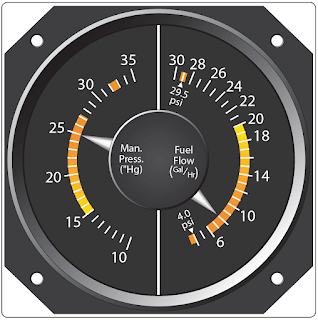Pressure is the amount of force acting on a specific amount of surface area. The force is typically measured in pounds and the surface area in square inches, making the units of pressure pounds per square inch or psi. If a 100-lb weight was placed on top of a block with a surface area of 10 in2, the average weight distribution would be 10 lb for each of the square inches (100 ÷ 10), or 10 psi.
When atmospheric pressure is being measured, in addition to psi, other means of pressure measurement can be used. These include inches or millimeters of mercury, and millibars. Standard day atmospheric pressure is equal to 14.7 psi, 29.92 inches of mercury ("Hg), 760 millimeters of mercury (mm hg), or 1013.2 millibars. The relationship between these units of measure is as follows:
1 psi = 2.04 "Hg
1 psi = 51.7 mm Hg
1 psi = 68.9 millibars
The concept behind measuring pressure in inches of mercury involves filling a test tube with the liquid mercury and then covering the top. The test tube is then turned upside down and placed in an open container of mercury, and the top is uncovered. Gravity acting on the mercury in the test tube will try to make the mercury run out. Atmospheric pressure pushing down on the mercury in the open container tries to make the mercury stay in the test tube. At some point these two forces, gravity and atmospheric pressure, will equal out and the mercury will stabilize at a certain height in the test tube.
When atmospheric pressure is being measured, in addition to psi, other means of pressure measurement can be used. These include inches or millimeters of mercury, and millibars. Standard day atmospheric pressure is equal to 14.7 psi, 29.92 inches of mercury ("Hg), 760 millimeters of mercury (mm hg), or 1013.2 millibars. The relationship between these units of measure is as follows:
1 psi = 2.04 "Hg
1 psi = 51.7 mm Hg
1 psi = 68.9 millibars
The concept behind measuring pressure in inches of mercury involves filling a test tube with the liquid mercury and then covering the top. The test tube is then turned upside down and placed in an open container of mercury, and the top is uncovered. Gravity acting on the mercury in the test tube will try to make the mercury run out. Atmospheric pressure pushing down on the mercury in the open container tries to make the mercury stay in the test tube. At some point these two forces, gravity and atmospheric pressure, will equal out and the mercury will stabilize at a certain height in the test tube.
Under standard day atmospheric conditions, the air in a 1- in2 column extending all the way to the top of the atmosphere would weigh 14.7 lb. A 1 in2 column of mercury, 29.92 inches tall, would also weigh 14.7 lb. That is why 14.7 psi is equal to 29.92 "Hg. Figure 1 demonstrates this point.
Figure 4 shows a differential pressure gauge for the pressurization system on a Boeing 737. In this case, the difference in pressure is between the inside and the outside of the airplane. If the pressure difference becomes too great, the structure of the airplane could become overstressed.
RELATED POSTS
 |
| Figure 1. Atmospheric pressure as inches of mercury |
Gauge Pressure
A gauge pressure (psig) is a reading that refers to when an instrument, such as an oil pressure gauge, fuel pressure gauge, or hydraulic system pressure gauge, displays pressure which is over and above ambient. This can be seen on the fuel pressure gauge shown in Figure 2. When the oil, fuel, or hydraulic pump is not turning, and there is no pressure being created, the gauge will read zero. |
| Figure 2. Psig read on a fuel pressure gauge |
Absolute Pressure
A gauge that includes atmospheric pressure in its reading is measuring what is known as absolute pressure, or psia. Absolute pressure is equal to gauge pressure plus atmospheric pressure. If someone hooked up a psia indicating instrument to an engine’s oil system, the gauge would read atmospheric pressure when the engine was not running. Since this would not make good sense to the typical operator, psia gauges are not used in this type of application. For the manifold pressure on a piston engine, a psia gauge does make good sense. Manifold pressure on a piston engine can read anywhere from less than atmospheric pressure if the engine is not supercharged, to more than atmospheric if it is supercharged. The only gauge that has the flexibility to show this variety of readings is the absolute pressure gauge. Figure 3 shows a manifold pressure gauge, with a readout that ranges from 10 "Hg to 35 "Hg. Remember that 29.92 "Hg is standard day atmospheric. |
| Figure 3. Manifold pressure gauge indicating absolute pressure |
Differential Pressure
Differential pressure, or psid, is the difference between pressures being read at two different locations within a system. For example, in a turbine engine oil system the pressure is read as it enters the oil filter, and as it leaves the filter. These two readings are sent to a transmitter which powers a light located on the flight deck. Across anything that poses a resistance to flow, like an oil filter, there will be a drop in pressure. If the filter starts to clog, the pressure drop will become greater, eventually causing the advisory light on the flight deck to come on.Figure 4 shows a differential pressure gauge for the pressurization system on a Boeing 737. In this case, the difference in pressure is between the inside and the outside of the airplane. If the pressure difference becomes too great, the structure of the airplane could become overstressed.
 |
| Figure 4. Differential pressure gauge |
RELATED POSTS
